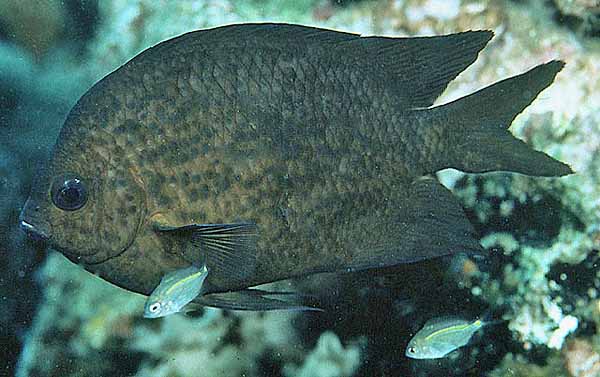Acanthochromis polyacanthus
(Bleeker, 1855)
|
Familie: Pomacentridae SynonymeDascyllus polyacanthus Bleeker, 1855 Lokale Bezeichnung |
Typen
Holotypus: ? BMNH 1862.2.28.33.
Siehe: Eschmeyer, W.N., Fricke, R. & Van der Laan, R. (eds.) 2024. Catalog of Fishes electronic version
Typusfundort: Batjan, Molukken, Indonesien.
Etymologie
Poly (= viele); acanthus (= Dorn), bezieht sich auf 17 Rückenflossenstacheln. (Übersetzt aus: The ETYFish Project)
Verbreitung
Westlicher Pazifik: Ostindonesien östlich bis zu den Philippinen, Neuirland (Papua-Neuguinea), Salomonen und Vanuatu, südlich bis Nordaustralien und Neukaledonien.
IUCN Status

EX Extinct (ausgestorben)
EW Extinct in the Wild (in der Natur ausgestorben)
CR Critically Endangered (vom Aussterben bedroht)EN Endangered (stark gefährdet)
VU Vulnerable (gefährdet)
NT Near Threatened (potenziell gefährdet)
LC Least Concern (nicht gefährdet)
RE Regionally Extinct (regional oder national ausgestorben)DD Data Deficient (ungenügende Datengrundlage)
NE Not Evaluated (nicht beurteilt)
LC Least Concern (nicht gefährdet)
Gefahren für diese Art: Diese Art ist potenziell durch die Ausbeutung für den Aquarienfischhandel bedroht, aber dies ist begrenzt. Sie kann auch durch die Dynamitfischerei auf den Philippinen und in Indonesien im Bestand beeinträchtigt werden.
Literatur
- Bleeker, P. 1855. Derde bijdrage tot de kennis der ichthyologische fauna van Batjan. Natuurkundig Tijdschrift voor Nederlandsch Indië, 9 (3): 491-504. (BHL) Zitatseite [: 503, !!, als Dascyllus polyacanthus]
- Gill, T.N. 1863. Synopsis of the pomacentroids of the western coast of North and Central America. Proceedings of the Academy of Natural Sciences of Philadelphia, 15: 213-221. (BHL) Zitatseite [:214, Beschreibung, als Acanthochromis polyacanthus]
- Alleyne, H.G. & Macleay, W. 1877. The ichthyology of the Chevert expedition. Proceedings of the Linnean Society of New South Wales, 1 (3-4): 261-281, 321-359, Pls. 3-9, 10-17. (BHL) Zitatseite [:343, Pl. 15 (fig. 3), !!, als Heptadecanthus longicaudis]
- De Vis, C.W. 1885. New fishes in the Queensland Museum. No. 5. Proceedings of the Linnean Society of New South Wales, 9 (4): 869-887. (BHL) Zitatseite [:872, !!, als Heptadecanthus brevipinnis; :873, !!, als Heptadecanthus maculosus]
- Seale, A. 1906. Fishes of the South Pacific. Occasional Papers of the Bernice Pauahi Bishop Museum of Polynesian Ethnology and Natural History, 4 (1): 1-89, 1 pl. Zitatseite [:53, Fig. 2, !!, als Abudefduf jordani]
- Fowler, H. W. & Bean, B. A. 1928. Contributions to the biology of the Philippine Archipelago and adjacent regions. The fishes of the families Pomacentridae, Labridae, and Callyodontidae, collected by the steamer Albatross, chiefly in Philippine seas and adjacent waters. Bulletin of the United States National Museum, (100) 7: i–viii + 1–525, Pls. 1–49. Zitatseite [:51, !!, als Chromis desmostigma]
- Robertson, D.R. 1973. Field observations on the reproductive behaviour of a pomacentrid fish, Acanthochromis polyacanthus. Zeitschrift für Tierpsychologie, 32 (3): 319-324. (doi) Zitatseite [:319-324|Verhalten, Fortpflanzung ]
- Eschmeyer, W.N. 1990. Catalog of the genera of Recent fishes. California Academy of Sciences, San Francisco. i-v + 1-697. Zitatseite [: 9, gelistet ]
- Allen, G.R. 1991. Riffbarsche der Welt. Mergus Verlag, Melle. Zitatseite [: 28, Farbfoto, Synonyme, Beschreibung, Vorkommen ]
- Thaler, E. 1998. RIffbarsche im Riffaquarium! Die Aquarien- und Terrarienzeitschrift (DATZ), 51 (8): 524-528. Zitatseite [:524ff|Farbfoto, Fortpflanzung, Aquarienhaltung ]
- Thaler, E. 1998. Schwalbenschwanz-Riffbarsche. Die Aquarien- und Terrarienzeitschrift (DATZ) 51 (9): 576-582. Zitatseite [:576ff|Farbfoto, Fortpflanzung, Aquarienhaltung ]
- Thaler, E. 1999. Betr.: Acanthochromis polyacanthus (DATZ 9/1998). Die Aquarien- und Terrarienzeitschrift (DATZ), 52 (6): 64. Zitatseite [:64|Farbfoto, Farbfoto, Juvenil ]
- Groß, O. 2000. Kleinfischzucht im Riffaquarium. Aqualog News, #33: 5, 8. Zitatseite [:5*|Farbfoto ]
- Hilder, M.L. & Pankhurst, N.W. 2003. Evidence that temperature change cues reproductive development in the spiny damselfish, Acanthochromis polyacanthus. Environmental Biology of Fishes, 66 (2): 187-196. (doi) Zitatseite [:187ff|Fortpflanzung, Physiologie ]
- Finck, H. & Frische, J. 2004. Die Familie Pomacentridae. Teil 1: Einleitung und die Gattung Dascyllus. Das Aquarium, #423, (9): 56-66. Zitatseite [:58*|Farbfoto ]
- Tang, K.L., Stiassny, M.L.J., Mayden, R.L. & DeSalle, R. 2021. Systematics of Damselfishes. Ichthyology & Herpetology, 109 (1): 258–318. (doi) Zitatseite [: 293, Phylogenie, in Hemiglyphidodontini]]
